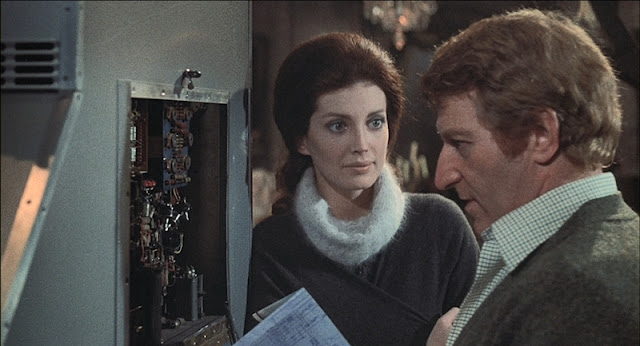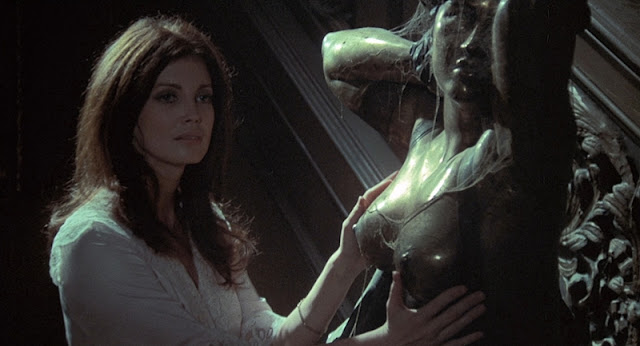(1973) Directed by John Hough; Written by Richard Matheson
(based on his novel, Hell House); Starring: Roddy McDowall, Pamela
Franklin, Clive Revill, Gayle Hunnicutt and Roland Culver; Available on Blu-ray
and DVD
Rating: ****
Dr. Lionel Barrett (Clive Revill): "Is there anything you’d care to tell us?"
Benjamin Fischer (Roddy McDowall): "What’s to tell? The house
tried to kill me; it almost succeeded."
While there’s no shortage of haunted house movies, good ones are a scarce commodity. To show ghosts or not to show ghosts, that is the question (my apologies to the Bard). There’s a constant push-pull between suggesting and showing supernatural phenomena. Both are valid approaches, in the right hands. On one end of the spectrum is Robert Wise’s masterful adaptation of Shirley Jackson’s The Haunting of Hill House, which proves it’s not what you see, but what you think you see that’s terrifying. In the opposite direction lies William Castle’s 13 Ghosts (1960) – its whole raison d'être is about seeing the spirits (hence, the “Ghost Viewer” gimmick). Somewhere near the Haunting side of the spectrum resides director John Hough’s* The Legend of Hell House,** based on Richard Matheson’s 1970 novel, Hell House. Hough admired Robert Wise’s restrained touch in The Haunting (1963), and wanted to create that same level of atmosphere, relying on suggestion above visual thrills. Transplanted from the novel’s New England setting to the British countryside, The Legend of Hell House was filmed at Wykehurst Place*** in Bolney, West Sussex, England (the same location where 1972 productions All the Colors of the Dark and Demons of the Mind were also shot).
* Fun Fact #1: According to Hough, among the movies he’s directed, the following titles are his favorite (listed in order): The Legend of Hell House (1973); Dirty Mary, Crazy Larry (1974); and Escape to Witch Mountain (1975).
** Fun Fact #2: This was the second outing with producer Albert Fennell and star Pamela Franklin, who both worked on another landmark ghost film, The Innocents (1961).
***
Fun Fact #3: Only the exterior of the Gothic Revival mansion appears in the
film. The interiors were shot on a set in Elstree Studios. Hough noted that
rooms on the set were much larger than the rooms in the actual house.
Dr.
Lionel Barrett (Clive Revill), a physicist, is challenged by elderly
millionaire Mr. Deutsch to assess the veracity of alleged supernatural activity
in the infamous Belasco House. Known as the “Mount Everest of haunted houses,”
the imposing mansion was built by eccentric millionaire Emeric Belasco, known
as the “roaring giant.” The house became the epicenter for all manners of
debauchery (“Drug addiction, alcoholism, sadism, bestiality, mutilation,
murder, vampirism, necrophilia, cannibalism, not to mention a gamut of sexual
goodies. Shall I go on?”). Barrett intends to find the secret of Hell House, and
with the aid of his custom-built machine, rid the place of its malevolent
energy once and for all. Along with his wife Ann (Gayle Hunnicutt), Barrett
brings along two psychics, Ben Fischer (Roddy McDowall) and Florence Tanner
(Pamela Franklin), to provide a counterbalance to his inquiry. Despite his
rational, empirical-based approach, he soon discovers that he’s not immune to
the house’s influence.
Dr.
Barrett is so smugly confident in his scientific approach, he’s unwilling to
accept any interpretations that don’t conform to his narrow definition of
supernatural phenomena. He includes Fischer and Tanner, seemingly only to
downplay or ignore their observations. His device serves as an extension of his
ego (something his character shares with Belasco), with his anticipated success
merely an opportunity to gloat over his colleagues – a triumph of science over the
unexplained.
Although not a formal member of Barret’s research team, his wife Ann (Edith in the novel) is more than a passive participant. An ardent supporter of her husband’s career, she’s blindsided by the strange goings-on in the Belasco house. Her character is alternately frustrating and sympathetic. She defines herself by his accomplishments, but she’s little more to him than an appendage. Their relationship is typified by a scene where he deflects her offer for help with his machine, condescendingly intimating that it’s beyond her understanding. Meanwhile, she represses her own ambitions and desires, which the house exploits. Her sexual frustrations come to a head when she tries in vain to seduce Fischer.
If
Dr. Barrett represents the exploration of the tangible, Florence Tanner is his philosophical
antithesis. Tanner views her mediumship not as a mere profession, but a
spiritual calling, based in her feelings and beliefs. She describes herself as
a psychic medium, but as she gets closer to what she believes to be the answer
(or perhaps steered further from the truth), her psychic gifts become physical.
Despite her colleagues’ doubts, Tanner persists in the belief that she’s in
contact with Emeric Belasco’s deceased, eternally tortured son Daniel. Much
like Barrett, her unshakable belief that she’s on the right path proves to be
her undoing.
Benjamin
Franklin Fischer (Roddy McDowall) is a burnt-out once child prodigy (known for
his unparalleled talent for detecting and manifesting psychic phenomena). He
carries a heavy burden – of the last team of psychic researchers to investigate
the house, he was the only one to make it out alive. Now, he’s a broken man, dubious
of Barrett’s convictions, and the doctor’s blind faith in his machine (“You do
not fight this house.”). Still traumatized by his past experience in the
Belasco house, he purposely holds back, reluctant to open himself up to the
forces that dwell within. McDowall’s superb performance anchors the film, as a
man grappling with his inner demons, torn between self-protection and facing
the trauma that nearly destroyed him.
A common thread running throughout the film is a clash of differing philosophies, between the obstinate, unwavering Dr. Barrett’s adherence to science, versus Tanner and Fischer’s reliance on the intangible as their evidence. To Barrett, the house’s disturbances can be attributed merely to electromagnetic radiation, the residual, unfocused energy from Belasco and his guests, but to Tanner and Fischer, there is an unseen intelligence at work. Who’s right and who’s wrong? Without spoiling the films conclusion, Richard Matheson (who adapted his own novel for the screenplay) provides a case to support both points of view, where Dr. Barrett and Florence are at once refuted and vindicated.
The filmmakers utilize a barrage of traditional, albeit effective, devices to create an atmosphere of unease: whispered voices, shaking tables, creepy lighting, and inventive camerawork.* An early electronic score by Delia Derbyshire and Brian Hodgson further contributes to an otherworldly, disconcerting experience. Of course, none of these elements would matter if the actors weren’t up to snuff, but the excellent cast rise to the task. It’s a mostly faithful adaptation of the novel that occasionally pulls its punches (the film version does away with the sexual tension between Florence and Ann), but ultimately captures the main themes of the source material. I can excuse a somewhat underwhelming ending (which attempts to wrap things up into a neat box), because it’s what The Legend of Hell House gets right that sticks with us. It’s unnerving and spooky, with as much to say about the here and now, as with the spirit world. As with all great stories about hauntings, it’s not about the dead, but the living, and the baggage they bring along.
*
Fun Fact #4: According to Pamela Franklin, Hume was a perfectionist, who
enjoyed experimenting with different lighting equipment. He allegedly took so
much time setting up the shots that the crew started hiding his lights.
Sources
for this article: Shout Factory DVD commentary by Pamela Franklin; “The Story
of Hell House: An Interview with John Hough”; Hell House, by Richard Matheson










Good review, barry!
ReplyDeleteI had to watch The legend of hell House just for Roddy McDowell and was not disappointed! To be honest, I prefer it over the haunting.
Thanks, John! I'm more of a "Haunting" person, myself, but this is a solid picture. Roddy McDowall is terrific in this. He captured the character from the book perfectly.
DeleteGreat pick for the Halloween season Barry! I too favor The Haunting, but Hell House is very, very good and stands up well with repeated viewings. I was so intrigued by the movie that I sought out the Matheson novel - it was the first time I encountered the concept of ectoplasm! Really good ghost/haunted house films are rare, so this, and The Haunting, are ones to treasure.
ReplyDeleteThanks, Brian! I've been meaning to cover this one for a while. Although I have a few minor quibbles about the adaptation of the novel, I think the film works in most of the places where it counts the most. On a different note, I wonder how many folks thought ectoplasm was introduced with Ghostbusters?
Delete